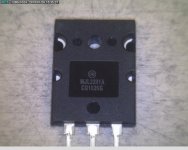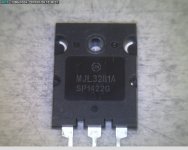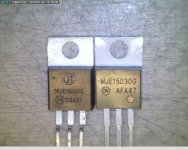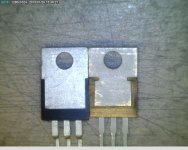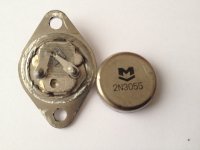About a year ago I posted here that the MJL1302/MJL3281 had changed appearance with the replacement of the A-version with the AG-version. In addition I posted a little further (#506) that the datecoding system had changed from YYWW to YWW with a letter indicating the year > 2010)
As of 2014, the datecoding system was changed back to the YYWW system. OnSemi's smaller transistors stick to the YWW datecoding system where a single letter indicates the year.
I never posted a picture of the TO-220 range (e.g. MJE15030/15031), but around the same time the bigger brothers changed appearance, so did these smaller types.
As of 2014, the datecoding system was changed back to the YYWW system. OnSemi's smaller transistors stick to the YWW datecoding system where a single letter indicates the year.
I never posted a picture of the TO-220 range (e.g. MJE15030/15031), but around the same time the bigger brothers changed appearance, so did these smaller types.
Last edited:
In addition to my previous post, I took some photographs of a MJL3281A "old style" and "new style". I just noticed that the new version is type A again, rather than AG. Last year I thought I found that the A was going obsolete.
The change happened at the end of 2012. From then on we've used hundreds of these and never saw the old style again.
Also some pics of an MJE15030 old style and new style. The datecode seems to indicate a change in 2010 as the most recent batch carries E47, presumably meaning week 47 of 2014. If so, counting backwards must mean that A = 2010.
Again, after the change the old style was never seen again, so if you're dealing with these that have a datcode of > 2010, but look like the one on the left, I'd say it's a fake.
The change in how they look must be the result of moving the production location. In both cases the first two letters were changed. From some research on OnSemi's LM337 (because of a problematic batch), the first letter indicates the plant at which they were assembled. E.g. on the LM337, lot trace codes starting with "R" mean they were assembled at a plant in Roznov, Czech Republic.
Just in case you wonder: all these transistors were bought from authorised distributors like Avnet of Arrow and are 99.9999999% certain to be genuine.
The change happened at the end of 2012. From then on we've used hundreds of these and never saw the old style again.
Also some pics of an MJE15030 old style and new style. The datecode seems to indicate a change in 2010 as the most recent batch carries E47, presumably meaning week 47 of 2014. If so, counting backwards must mean that A = 2010.
Again, after the change the old style was never seen again, so if you're dealing with these that have a datcode of > 2010, but look like the one on the left, I'd say it's a fake.
The change in how they look must be the result of moving the production location. In both cases the first two letters were changed. From some research on OnSemi's LM337 (because of a problematic batch), the first letter indicates the plant at which they were assembled. E.g. on the LM337, lot trace codes starting with "R" mean they were assembled at a plant in Roznov, Czech Republic.
Just in case you wonder: all these transistors were bought from authorised distributors like Avnet of Arrow and are 99.9999999% certain to be genuine.
Attachments
Last edited:
Small corrections to above post:
Datecodes starting with A = 2011, not 2010. The change from old to new style with the TO-220 was somewhere during 2011. For the TO-264 it was during 2012.
Newest datecodes on the current work in progress could therefore never have been starting with E (they're actually C, i.e. 2013).
Datecodes starting with A = 2011, not 2010. The change from old to new style with the TO-220 was somewhere during 2011. For the TO-264 it was during 2012.
Newest datecodes on the current work in progress could therefore never have been starting with E (they're actually C, i.e. 2013).
Wondering about this MH15003G
Popped one open. It measured 2.83nF
Die looks suspiciously small, and the silicon goo all over... hmm
Insights? Didn't even know people made fake transistors, that's like putting a lot of work into faking working at work or something...
Popped one open. It measured 2.83nF
Die looks suspiciously small, and the silicon goo all over... hmm
Insights? Didn't even know people made fake transistors, that's like putting a lot of work into faking working at work or something...
An externally hosted image should be here but it was not working when we last tested it.
Wondering about this MH15003G .....
I think you know the answer !!!!!
FAKE .
Andy
I'm getting genuine OnSemi MJ15003G from a reputable source in a few days. I'll pop one of them open too to compare.
Then I'll post who sold the fake ones, if that is allowed on the forums?
Then I'll post who sold the fake ones, if that is allowed on the forums?
I am trying to imagine the "faker" trying to sue you !I'm getting genuine OnSemi MJ15003G from a reputable source in a few days. I'll pop one of them open too to compare.
Then I'll post who sold the fake ones, if that is allowed on the forums?
Go ahead and provide us with a service.
I wonder if anyone has experience with the 2sc4686a from ebay seller hkutsource? Thinking of ordering some from them, not sure it's worth the time.
FYI, not saying they are fakes not to be sued by the seller, I've had problems with some components from ASWO pro seller. (Was once a decent seller.)
"Technics" STK8050, been through 3, output shorts instantly.
"Infineon" ICE3B2065J, they sell one more expensive one for "Samsung" no problems with that, the cheaper version (5263163) I've had one OK, one with not original-looking encapsulation and nothing semiconductor inside!
"CT" CT2N5551, had 4 pieces old stock from around 2006, used them all to replace the 2N3859A (Crown "2961", Q105, Q108, Q205, Q208) in an Amcron DC300A amp, one channel wouldn't bias, it turned out one of the 2N5551's was a PNP....
"Technics" STK8050, been through 3, output shorts instantly.
"Infineon" ICE3B2065J, they sell one more expensive one for "Samsung" no problems with that, the cheaper version (5263163) I've had one OK, one with not original-looking encapsulation and nothing semiconductor inside!
"CT" CT2N5551, had 4 pieces old stock from around 2006, used them all to replace the 2N3859A (Crown "2961", Q105, Q108, Q205, Q208) in an Amcron DC300A amp, one channel wouldn't bias, it turned out one of the 2N5551's was a PNP....
Wondering about this MH15003G
Popped one open. It measured 2.83nF
Die looks suspiciously small, and the silicon goo all over... hmm
Insights? Didn't even know people made fake transistors, that's like putting a lot of work into faking working at work or something...

Its not about making fakes but relabeling no name ones. TO3 package is very simple to clean and put whatever you want in letters on there😉
Or, relabeling items that came out the back door after failing the QA set up by the "name" supplier.
The ebay seller with the fake/rebranded MJ15003G was: eleleparts
I managed to get refunded, and bought the correct part from a reputable source instead.
I managed to get refunded, and bought the correct part from a reputable source instead.
Anyone recognise the maker ?
Probably Magnatec, which now makes some of the highest SOAR-rated BJTs in production by any company anywhere.
Hi,
I've just purchased some 2N3055s.
The die size looks OK as does the heat spreader.
Anyone recognise the maker ?
Andy
Do people also be carefull when open these transtistors? it can contain Beryllium oxide, and is is very dangerous.
Most is afcourse found in HF transistors but a warning is on his place here, special when fakes.
Last edited:
Probably Magnatec, which now makes some of the highest SOAR-rated BJTs in production by any company anywhere.
I doubt it as Magnatec's logo seems to be:
I agree with Anatech, no datecode doesn't instill any confidence, however good this one may appear visually.
- Home
- Design & Build
- Parts
- My Transistors, original or copy?



